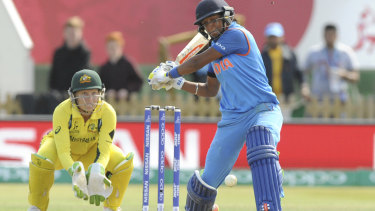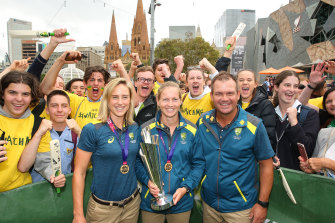‘We were exposed’: The uncertain start of an Australian cricket juggernaut
Not only is Alex Blackwell’s Fair Game one of the better sporting memoirs published in Australia in the past 10 years, it also provides a timely and at times searing window into the unsteady early days of the Meg Lanning/Matthew Mott leadership duo.
In 2022, Australia’s women are almost unassailable as the world’s best team, having scooped each of the past two T20 World Cups and set a world record for consecutive ODI victories during the same period. They begin their effort to regain the 50-over World Cup in New Zealand on Saturday.
India’s Harmanpreet Kaur goes on the attack during the 2017 World Cup semi-final.Credit:AP
Blackwell, though, reminds readers that the story of Australian women’s cricket did not begin with the 2018 T20 Cup success in the Caribbean. On the contrary, she contends that Australia really should have won both the T20 World Cup in 2016, when West Indies hammered them in the final, and the 50-over cup the following year, scooped by England after Harmanpreet Kaur dominated the Australians in the semi-final.
“While I’m so pleased for the team that they got the job done in 2018 and 2020, I feel frustrated that it took two World Cup failures for the tactical approach of the team to come into question and evolve,” Blackwell writes.
“While having a coach from the men’s environment certainly brought a more relaxed tone around how to switch off from cricket and enjoy each other’s company, I felt like the tactical approach suggested by the coaching team for the women’s game was very limited.
“The tactics seemed to focus on the most basic of plans because there was a belief that the women lacked the skills to execute more than that on a regular basis.”
Specifically, Blackwell states that the bowlers were under basic instruction to aim at the stumps while Lanning set straight fields, with little room for adjustment. As a consequence, West Indies in 2016 and India in 2017 could maintain the upper hand once they had made the early running.
Mott, who had a distinguished coaching career with NSW and Glamorgan before taking the women’s job in 2015, does not deny Blackwell’s version of events, but does add some context. He notes that the team had Joe Dawes and Ryan Harris as bowling coaches at various stages before settling on Ben Sawyer.
“That’s true, that happened, and I think it’s all part of that journey,” Mott tells The Age and The Sydney Morning Herald from New Zealand. “What we probably lacked in that tournament [in 2017] was plans B, C and D and we were exposed for that. The group have embraced that now in their own skills, and we talk a lot about certain bowlers that can create opportunities and others that can control the opposition.
“We probably weren’t in a place to be trying that at a World Cup. Those sorts of things need to be done behind the scenes, practiced and executed well before you can try to execute them under pressure in a World Cup. We had a less experienced bowling group that didn’t adapt as some of the times we’ve been put under pressure in the last couple of years.
Alex Blackwell tried in vain to get Australia home in the 2017 semi-final, making 90 from 56 balls. Credit:Getty Images
“We still make mistakes all the time, but that was one of our biggest lessons, and we were able to galvanise the group around that and make sure from that point on we didn’t keep making the same mistakes. Tactically, we had a different side back then, we didn’t have many bowling options to fall back on under pressure. We still pick our best six batters, but Meg’s got the option of seven almost frontline bowlers now, so I think our ability to react to the opposition coming at us is a lot better than it was.“
Communication and mental preparation were also raised by Blackwell as issues around the team. She recalls a discussion with Mott and Lanning where she felt the squad needed to talk more openly about the pressures of the 2017 World Cup during a pre-tournament camp, only to be told the leaders preferred a “business as usual” type approach.
Later, Blackwell conveys her hurt and confusion when, told she would be passed over for the captaincy if Lanning’s shoulder injury flared, a warm-up game had her standing in as captain anyway because the preferred back-up, Rachael Haynes, was not ready.
“Rachael had an ankle injury at that stage as well, so it was touch and go to see whether she was fit to perform as well,” Mott says. “We tried to be as transparent as we could so we could manage expectations, but in one of those practice matches Meg went off injured and Alex took over as captain for a few overs. When you look back, that was a missed opportunity where we should have communicated better, but you can’t get them all 100 per cent right.”
Matthew Mott, here with Ellyse Perry and Meg Lanning, has overseen great success after a slow start.Credit:Getty
For Lanning’s part, she acknowledges that getting clear and strong communication in place, where players know well in advance exactly what their roles will look like, has made for a significant step forward in the team’s consistency and performance.
“If you don’t communicate clearly and early enough, something we’ve identified is before each tour, we need to try to have a conversation with everyone around what their role looks like,” Lanning says. “Clearly a meeting with Alyssa Healy is very different to a meeting with Darcie Brown. Alyssa knows what her role is and with a new player, you need to give them more information and be quite clear. If you don’t do that early enough, or before you start playing games, that’s when it can become a little bit messy.
“That is something we do a lot better now than what we have in the past, clearly identifying what people’s roles are and communicating that as early and clearly as possible. It’s taken us a while to get to a method in delivering that message that works for everyone, but I feel like where we’ve got to now is everybody does understand what their role is and that makes it a lot easier on players, coaches and leadership in terms of what you’re expecting.
“Players really appreciate the honesty and the upfront conversations. Sometimes it’s not what they want to hear, but that’s better to get that upfront early, rather than the expectations they’ve got being different to what the coaches and leadership have. Once you know what the team is, you may as well communicate it as early as possible.”
As for Blackwell’s contention that the team’s evolution could have taken place more rapidly, allowing for ultimate success in the final two global tournaments of her career, Mott argues that time was required to build trust and openness that helped put Australia back at the pinnacle of the women’s game.
“When you win, you gloss over those mistakes a little bit, and when you lose you reflect on them and try to get better,” he says. “The fundamental difference between where we are now and where we were then is we’re a lot more open to admit those mistakes when we get it wrong and we try to rectify them as soon as possible.
“But that takes time. You have to build up trust in a group where people are open to give their opinions without fear they’ll be shot down. Alex was there I reckon at the start of this, and she probably wouldn’t recognise the meetings and how much they’ve progressed now, where players will actually call out some plays we got wrong. That shows the strength of the team.”
Lanning’s women get started in New Zealand from a position of enormous strength; Blackwell has offered a quality reminder of how they got there.
“While the experience of 2017 certainly changed the way we approached playing our cricket and has been very successful, the team heading into this World Cup is different and we’ve made a real point of focusing on what we’re moving into,” Lanning says. “World Cups are difficult to win, they’re very unique, you’re playing a new team every game, and it’s a different sort of pressure.”
News, results and expert analysis from the weekend of sport sent every Monday. Sign up for our Sport newsletter.
Most Viewed in Sport
From our partners
Source: Read Full Article



